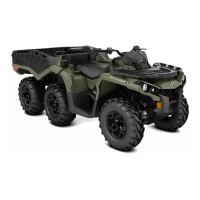
Do you have a question about the BRP CAN-AM OUTLANDER 6x6 2017 Series and is the answer not in the manual?
| Brand | BRP |
|---|---|
| Model | CAN-AM OUTLANDER 6x6 2017 Series |
| Category | Offroad Vehicle |
| Language | English |
Learn how to reduce the risk of injury or death by reading the guide and safety labels.
Recommends operators be 16 years or older to operate the vehicle safely.
Emphasizes the importance of proper instruction and training for ATV safety.
Explains the safety alert symbol and the meaning of WARNING, CAUTION, and NOTICE messages.
Details the purpose of the guide, availability in multiple languages, and tips for its use.
Covers crucial safety advice on carbon monoxide, gasoline hazards, burns, and modifications.
Highlights critical warnings about the vehicle's hazardous nature and the need for proper operation.
Details essential warnings for safe operation, including age, passenger, surface, and speed limits.
Outlines critical checks before each ride to ensure vehicle safety and prevent breakdowns.
Specifies essential protective gear including helmet, eye protection, and clothing.
Explicitly states the vehicle is designed for operator only; carrying passengers is prohibited.
Covers responsible riding, respecting others, the environment, and trail etiquette.
Discusses vehicle limitations and inherent dangers of off-road use.
Covers safe procedures for turning, braking, and reverse operation.
Guides on safely navigating obstacles on trails.
Provides detailed instructions for climbing hills safely.
Explains how to drive downhill safely.
Addresses risks of side-hilling and drop-offs, advising caution.
Covers hazards of water crossings and riding on ice.
Provides precautions for riding on snow.
Offers advice for riding on sand.
Discusses challenges of riding on loose stones or gravel.
Highlights the vehicle's utility for light tasks and the importance of following accessory instructions.
Explains how loads affect handling and stability, emphasizing load limits and secure distribution.
Details tire pressure and suspension adjustments for carrying loads, and loading procedures.
Specifies maximum load capacities for rear cargo boxes, beds, and tailgates.
Covers tilting the cargo bed and safe practices for hauling loads using a trailer hitch.
Details procedures and risks associated with pulling a trailer, including hitch compatibility and load balancing.
Importance of reading safety info on the hang tag.
Read and understand vehicle safety labels.
Highlights various on-product safety labels regarding age, passengers, and hazards.
Details labels concerning tire pressure, load capacity, and overloading warnings.
Covers labels on cargo bed operation, hitch usage, and general warnings.
Features labels on trailer loading, general warnings, and hot parts.
Safety info on hang tags for international markets.
Importance of vehicle safety labels for international models.
Covers international labels on age, passengers, and operational warnings.
Highlights international labels regarding age restrictions and passenger rules.
Details international labels on load capacity, operation, and road use.
Covers international labels on trailer loading and general warnings.
Details compliance labels (CE, CAN ICES) indicating vehicle conformity.
Explains the purpose and location of technical information labels.
Explains the function and operation of the throttle lever for controlling engine speed.
Describes the left-hand brake lever for slowing/stopping and the parking brake for securing the vehicle.
Details the brake pedal operation and the five-position shift lever (P, R, N, H, L).
Explains transmission modes and the Digitally Encoded Security System (D.E.S.S.) key.
Covers the headlight switch, emergency engine stop switch, and engine start button.
Explains the override function, DPS modes, and the 4WD/6WD selector switch.
Details the operation of the winch control switch for extending and retracting the cable.
Describes the multifunction gauge, including displays for speed, tachometer, and transmission position.
Explains various indicator lamps and gauge features, including mode selection.
Details functions like odometer, clock, trip meter, and hour meters for tracking distance and time.
Guides on how to set up the gauge's language and clock time.
Explains how to change unit settings (MPH vs KM/H) via an authorized dealer.
Covers the operator's seat design and the importance of keeping feet on footpegs.
Describes the convenience of the 12-volt outlet for accessories and its rating capacity.
Details the rear storage compartment, including opening, closing, and safety precautions.
Explains the utility of the front cargo rack and glove box for carrying equipment, with warnings against passengers.
Covers the trailer hitch for towing and the location of the tool kit for basic maintenance.
Details the operation and tips for using the winch and the function of the roller fairlead.
Describes the cargo bed's features and the tilt release handle, with safety warnings.
Explains the use of anchoring hooks for cargo security and the recovery hook for stuck vehicles.
Instructions for installing optional flat bed and forestry package components.
Guides for installing front LinQ rack and side walls.
Details the process of removing side walls and the tail gate, with safety warnings.
Guides on installing side walls and the tail gate, including securing with hairpin clips.
Instructions related to the farmer package.
Details how to remove the tail gate extension.
Guides on installing the tail gate extension, including aligning with LINQ openings and securing.
Covers cargo extensions, LinQ grips, and front LinQ racks.
Explains the process for removing and installing the hard top, including detaching shocks and side brackets.
Guides on inserting modular bags into the vehicle's LINQ openings.
Details the operation of heated hand grips and throttle for comfort in cold weather.
Describes the location and use of the heated visor outlet for visibility.
Outlines fuel requirements, including octane ratings and warnings about alcohol content.
Provides step-by-step instructions for safely fueling the vehicle, including safety warnings.
Details break-in procedures for engine, brakes, and belt to ensure proper performance.
Covers engine starting, D.E.S.S. key, emergency stop switch, and electrical system activation.
Explains how to shift the transmission and the importance of parking securely.
Guides on handling water in CVT and air filter housing, and vehicle immersion.
Guides on handling vehicle rollovers and immersion in water.
Explains how to adjust suspension preload for ride firmness and handling.
Describes the Tri-Mode DPS system and how to change assist levels.
Provides instructions on securely transporting the vehicle, with safety precautions.
Emphasizes maintenance importance and outlines conditions requiring increased air filter maintenance.
Details maintenance tasks required at specific mileage/hour intervals and annually.
Lists maintenance tasks required at longer intervals and every two years.
Guides on air filter removal, cleaning, oiling, and installation.
Covers checking engine oil level and performing oil changes.
Explains how to inspect the radiator and check engine coolant levels.
Details the procedure for draining, filling, and bleeding the cooling system.
Guides on cleaning and inspecting the muffler spark arrester.
Covers CVT air filter removal, cleaning, and installation.
Explains gearbox oil level verification and change procedures, including recommended oil.
Guides on lubricating and adjusting the throttle cable.
Covers spark plug access, removal, and installation, including gap setting.
Details battery removal, installation, and cleaning procedures.
Details fuse box locations, descriptions, ratings, and fuse inspection.
Covers headlight bulb replacement, beam aiming, and taillight bulb replacement.
Guides on visually inspecting drive shaft protectors and boots for damage.
Explains how to inspect wheel bearings and tire pressure.
Covers tire inspection, replacement, and wheel removal/installation.
Advises inspecting tie-rod boots for cracks.
Guides on inspecting suspension components and steering tie-rods.
Explains how to verify brake fluid levels.
Details adding brake fluid and performing brake inspections.
Advises rinsing the vehicle after use in saltwater or muddy conditions and lubricating parts.
Provides guidelines for cleaning the vehicle, warning against high-pressure washers and certain products.
Lists compatible and non-compatible cleaning products for vehicle care.
Discusses proper storage for extended periods and preparation after storage.
Explains how to locate and identify VIN and engine numbers for warranty and tracing.
Describes the D.E.S.S. key and its compliance with regulations.
Outlines regulations regarding tampering with the noise control system.
Provides noise emission and vibration values measured according to specific standards.
States that the EC-Declaration is not in this version and refers to the printed manual.
Lists detailed specifications for the engine type, valve train, bore, stroke, and displacement.
Outlines transmission, gearbox, electrical, and fuel system specifications.
Covers drive system type, ratios, and steering specifications.
Details suspension types, travel, shock absorbers, and brake system specifications.
Provides tire, wheel, dimensions, and weight/loading capacity specifications.
Lists engine and lubrication specs for 1000 models.
Outlines transmission, gearbox, electrical, and fuel system specs for 1000 models.
Covers drive system and steering specifications for 1000 models.
Details suspension and brake system specifications for 1000 models.
Provides tire, wheel, dimensions, and weight/loading capacity specs for 1000 models.
Provides solutions for common engine and vehicle operational issues.
Solutions for engine not starting, covering D.E.S.S. key, battery, fuses, and starter.
Troubleshooting steps for engines that crank but don't start, including fuel, spark, and flooding issues.
Continues starting issues and addresses lack of acceleration or power.
Covers engine overheating, backfire, misfire, and issues with reaching full speed.
Addresses problems with shift lever, vehicle movement, and steering assist.
Lists common gauge messages, their meanings, and troubleshooting steps.
Details warranty scope, limitations, exclusions, coverage period, conditions, and claims for USA/Canada.
Covers the warranty for emission control systems, including components and periods.
Outlines warranty scope, limitations, exclusions, period, conditions, and claims for international markets.
Defines warranty scope, limitations, exclusions, period, conditions, and claims for EEA, CIS, and Turkey.
Outlines specific terms for products sold in France, focusing on conformity and hidden defects.
Informs about the use of customer coordinates for safety, warranty, and marketing purposes.
Provides contact addresses and information for various global regions.
Advises owners to notify BRP of address changes or ownership transfers for safety recalls and warranty purposes.
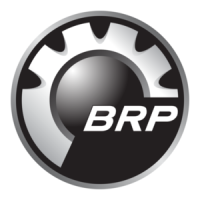


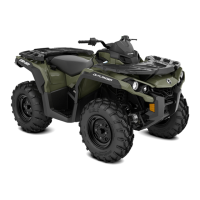
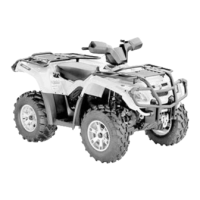
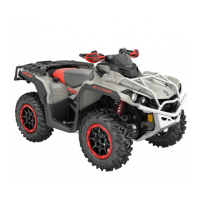






